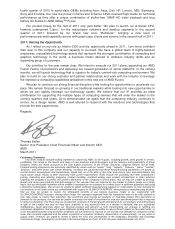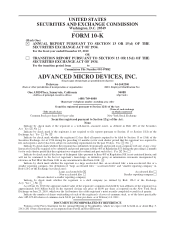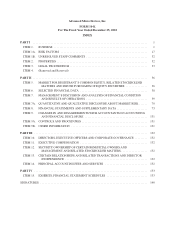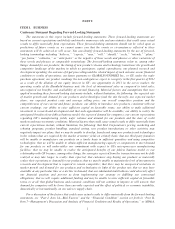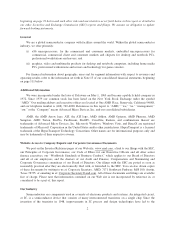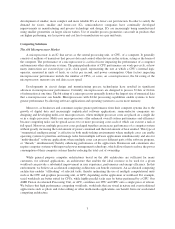AMD 2010 Annual Report Download - page 11
Download and view the complete annual report
Please find page 11 of the 2010 AMD annual report below. You can navigate through the pages in the report by either clicking on the pages listed below, or by using the keyword search tool below to find specific information within the annual report.development of smaller, more complex and more reliable ICs at a lower cost per function. In order to satisfy the
demand for faster, smaller and lower-cost ICs, semiconductor companies have continually developed
improvements in manufacturing and process technology and design. ICs are increasingly being manufactured
using smaller geometries on larger silicon wafers. Use of smaller process geometries can result in products that
are higher performing, use less power and cost less to manufacture on a per unit basis.
Computing Solutions
The x86 Microprocessor Market
A microprocessor is an IC that serves as the central processing unit, or CPU, of a computer. It generally
consists of millions of transistors that process data and control other devices in the system, acting as the brain of
the computer. The performance of a microprocessor is a critical factor impacting the performance of a computer
and numerous other electronic systems. The principal indicators of CPU performance are work-per-cycle, or how
many instructions are executed per cycle, clock speed, representing the rate at which a CPU’s internal logic
operates, measured in units of hertz, or cycles per second, and power consumption. Other factors impacting
microprocessor performance include the number of CPUs, or cores, on a microprocessor, the bit rating of the
microprocessor, memory size and data access speed.
Developments in circuit design and manufacturing process technologies have resulted in significant
advances in microprocessor performance. Currently, microprocessors are designed to process 32-bits or 64-bits
of information at one time. The bit rating of a microprocessor generally denotes the largest size of numerical data
that a microprocessor can handle. Microprocessors with 64-bit processing capabilities enable systems to have
greater performance by allowing software applications and operating systems to access more memory.
Moreover, as businesses and consumers require greater performance from their computer systems due to the
growth of digital data and increasingly sophisticated software applications, semiconductor companies are
designing and developing multi-core microprocessors, where multiple processor cores are placed on a single die
or in a single processor. Multi-core microprocessors offer enhanced overall system performance and efficiency
because computing tasks can be spread across two or more processing cores each of which can execute a task at
full speed. Moreover, multiple processor cores packaged together can increase performance of a computer system
without greatly increasing the total amount of power consumed and the total amount of heat emitted. This type of
“symmetrical multiprocessing” is effective in both multi-tasking environments where multiple cores can enable
operating systems to prioritize and manage tasks from multiple software applications simultaneously and also for
“multi-threaded” software applications where multiple cores can process different parts of the software program,
or “threads,” simultaneously thereby enhancing performance of the application. Businesses and consumers also
require computer systems with improved power management technology, which allows them to reduce the power
consumption of their computer systems thereby reducing the total cost of ownership.
While general purpose computer architectures based on the x86 architecture are sufficient for many
customers, for selected applications, an architecture that enables the ideal resource to be used for a given
workload can provide a substantial improvement in user experience, performance and energy efficiency. In this
environment, we believe an accelerated computing architecture can benefit customers. An accelerated computing
architecture enables “offloading” of selected tasks, thereby optimizing the use of multiple computational units
such as the CPU and graphics processing unit, or GPU, depending on the application or workload. For example,
serial workloads are better suited for CPUs, while highly parallel tasks may be better performed by a GPU. Our
AMD Fusion Accelerated Processing Unit, or APU, combines our CPU and GPU onto a single piece of silicon.
We believe that high performance computing workloads, workloads that are visual in nature and even traditional
applications such as photo and video editing or other multi-media applications can benefit from our accelerated
computing architecture.
3




